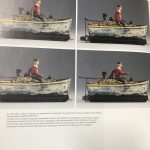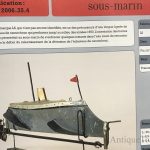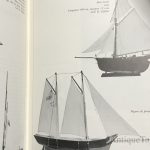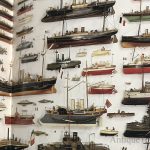Toy Boat For Sale– Where do they go?
Paging through my reference books like The Forbes Collection- Toy Boats and The Allure of Toy Ships I’ve been realizing the obvious– boat collecting is rarified air. Unfortunately the 19th and 20th century toy boats just weren’t made in large numbers. Prices have always been astronomical. Then of course, they were used to death. These days, one beautiful boat toy can cost as much as a car; or a home.
So where did the toy boats go? I see them in pages, but think they’ve gone into collections and won’t be seen in some time. I’ve been on a tear to get older published materials on long-gone boat toys. At least I can enjoy their images.
To supplement my knowledge, lately I’ve been reaching out for non-English reference books on boats. I’m a fan of older publications and references, as they have a stronger chance of having truly original toy examples. There is nothing like seeing a 1970’s photo of an item in original condition. You have a chance that the collector had it their entire life time & it stayed pristene because of the footnoted curator.
Below are two great French Toy boat book mini-reviews to help. These titles can be looked up online or help with your book store requests or online searches.
—————
Mateau Jouets (Boat Toys) 1850-1950 from the National Marine Museum is an impressive reference. The photos are quite captivating; as the book opens with a man and wife sitting at home at the dinner table. Stacked to their side are about ten Arks. On the table are seven open buckets of paint with brushes. Mom and dad are carefully hand painting details on arks as the photographer snaps the shot. Later we see three women in a massive Carette factory stoically sitting for a photo. Two men stand above them and then shelves of toy parts line the shelves. The pictures paint the story of the countless hours it took to make these boats and similar steam implements.
Later color plates show boats in museum style of cataloging. We see the Maker, date, country, material, audience, and beautiful detailed photos. One LM boat from France gets cut-away treatment, showing the rubber band propulsion. Later we see a jaw dropping steam ship by Inconnu from 1859. It has twin screws with a brass boiler and stunning detailing. The black and green hull is set off with twin sails, twin paddles, golden sea dragons, and intricate riggings.
Everything in Bateaux 1850-1950 is perfect and exacting. The book showcases toy boats as exactingly as the National Marine Museum. The only book shortcoming–I wanted more. I give deep compliments to the authors and greatly appreciate their boat toy publication.
———–
Les Bateaux 1830-1920 by Jac and Frederic Remise is a better reference book yet. It was published in 1981 and still commands over $100 as a book purchase. It is worth every dollar if you wish to build your knowledge on boat toys, especially early ones. There are 310 pages of stunning toys.
Most toys get one black and white photo with maker, size, propulsion, collector audience, and home country. Unfortunately these don’t get the color treatment of modern books, but you can tell how magnificent the craftsmanship is on each boat. Hulls are sculpted not injected, rails are delicately placed, and then most ships bristle with armorments.
The highlight of this book is the twin color centerfold plates. We see over 50 boats on a while wall. Unfortunately this exhibit isn’t in my home town, but you can still visit it from afar.
Due to the time span of Lex Bateaux 1830-1920, this publication better covers sailing ship toys. Towards the end we get pond yachts, racing yachts, and even Navy battle sailing vessels. Many of the toy boats haven’t been seen or sold in some time.
Lex Bateaux 1830-1920 works and succeeds as being a toy boat encyclopedia. I review photos with envy and can see past the French footnotes. Each toy is beautiful and collectors can find the necessary details to lust.
-Ed








